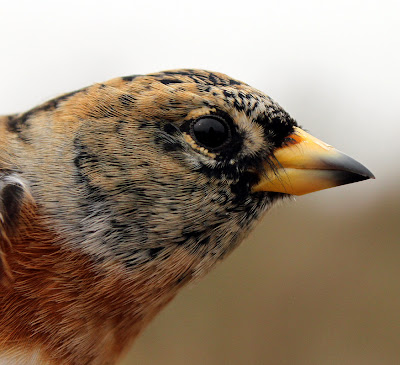The day to day ringing must go on, and after Wednesday’s surprise catch of the Little Bunting today’s effort was bound to be a more mundane affair. So it proved, a very slow morning saw just 9 birds caught, 4 new and 5 recaptures. Four new comprised 3 Chaffinch and 1 Brambling, the five recaptures 2 Reed Bunting, 2 Brambling and 1 Chaffinch.
With very few birds about the area I had the distinct impression that the finch flocks of recent months are now well and truly finished and flown to pastures new: the three new Chaffinches were all on the larger size ( 2 x females at 86mm and 1 x male at 93mm) suggesting they may be heading east and north rather than staying in these parts. If the ringing was sluggish the signs of spring were equally so with nothing resembling the March migration that can occur in warmer periods. Last March I was busy catching dozens of Lesser Redpolls as Meadow Pipits and wagtails headed north over my head, but with the current cold weather and northerly winds migration will be delayed.
There are just token photographs from the ringing today, but maybe a Lesser Redpoll portrait soon?
Brambling
Chaffinch
There were a few signs of Spring, mainly in the form of 3 loudly drumming Great-spotted Woodpeckers at dawn, this followed quickly by a Corn Bunting singing from the annual tree; I don’t know what the Corn Bunting will do if that tree disappears.
Other sightings: 1 Barn Owl, 3 Buzzard, 4 Kestrel (2 pair), 2 Stock Dove (pair), 14 Fieldfare, 2 Jay, 1 Grey Heron, 4 Shelduck, 12 Tree Sparrow, 8 Corn Bunting.
So there’s yet another Kestrel photo.
Common Kestrel
The Robin waited patiently for breakfast again this morning, the light falling in a better direction for a portrait. What a Little Stunner our common or garden Robin is, much better looking than a Little Bunting!
Robin
Click your way to Another Bird Blog very soon for more news and pictures of spectacular birds, rare or otherwise. Linking to Weekly Top Shot and I'd-rather-b-birdin.blogspot.with Mr Robin above.















































.jpeg)






.jpg)












